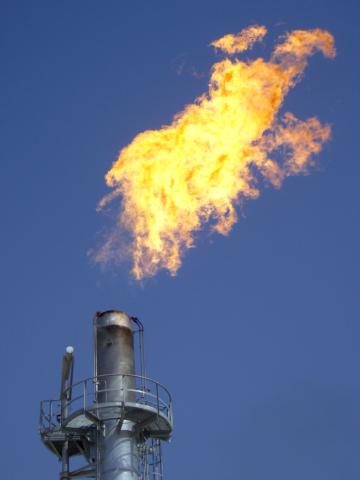
For the past couple weeks we discussed BTU monitoring in chemical processes; WHY you should monitor your flare stack & with WHAT technology. This week let's look at HOW you would do just that, in real life applications:
Heating Value - A leading supplier of performance polymers uses flare stacks to dispose of the waste products collected from its various chemical processes. The waste products consist of gases and other unknown substances. They can use the waste gas stream to supplement the fuel supply that operates their flare stacks; but first they have to identify the minimum heating value of the waste stream, to determine whether it can be used as a standalone fuel source or whether it needs to be blended with a constant fuel source (natural gas).This can all be done by continously monitoring the waste stream.
If the heating value of their waste stream drops below 350 BTU/ft3 (EPA code 60.18 states the waste stream must run at a minimum heating value of between 300-450 BTU/ft3), natural gas must be added to the flare stack to keep it running properly. Since their waste stream is made up of a wide variety of gases, they needed an analyzer that would measure the total heating value of the unknown gases in the stream. In addition, they wanted the analyzer to have a fast response time to quickly respond and activate their controls & modulate between the waste stream and natural gas.
- They chose a micro-combustion calorimeter, the CalorVal BTU Analyzer. It has the ability to accurately and continuously measure the direct BTU content of the varying waste gas stream. It is a real time measurement and will quickly respond (< 4 sec) to the alarm set point and adjust the natural gas concentration as needed.
The results speak for themselves, installing this analyzer optimized their fuel savings, allowed them to meet EPA guidelines for maximum 98% destruction efficiency of their flare stack , and becase they noticed that their waste stream is typically higher than 350 BTU/ft3, they very rarely need to use natural gas at all!
Find out more details.
Assist Gas Measurement - This particular manufacturer of solvents, polymers and intermediary chemicals, has a large site, as in thousands of acres. Its production units are high‐volume continuous processes that operate 24 hours, seven days a week. Flare stacks are used to dispose of the waste products from the many batch chemical processes. Their waste streams contain many components such as ethylene, propylene, natural gas, mineral spirits, ethyl acetate, ethanol, hydrogen, isobutyl acetate and isobutanol, just to name a few.
They were looking into several flare stack monitoring requirements that they were expecting to be required by the state. One area of concern was for measuring BTUs. They needed to continuously monitor the BTU concentration of the flares to ensure greater than 200 BTU/SCF for compliance purposes and control of assist gas flow rates. The monitoring range was from 250‐2500 BTU/SCF.
Their initial preference was for a Calorimeter type measurement with fast response and GC measurement only where additional gas make‐up information was required. Ultimately, they were looking for a reliable and proven analyzer.
- They chose to initially install the CalorVal BTU Analyzer on their most demanding application, knowing that if the analyzer could handle this it could certainly handle the others. The micro‐combustion technology of the CalorVal was compared to the thermopile technology of other calorimeters and it met and exceeded their expectations. They have now implemented an installation schedule to equip all of their flare stacks with the CalorVal solution.
Find out more details.
Fuel Additives - A worldwide manufacturer of fuel additives that improve the refining process and boost the performance of gasoline and other fuels, runs different batch processes. The waste streams from these processes consist mostly of isobutylene and propylene and are all vented to steam‐assist flares. EPA 60.18 mandates them to maintain 300 BTU/SCF lower heating value (LHV) of their waste stream to the flare all the time. They enrich it with natural gas if required. They use Doppler ultrasonic flow meters to measure the flow rates and have calculated the heat content based on flow measurement of waste gas and supplemental gas.
The EPA wanted them to have a direct, real time measurement of the LHV with either a Gas Chromatograph (GC) or a calorimeter and have the data available for an EPA audit (no longer would accept a calculated BTU value); the company wanted a fast response time due to the nature of their batch processes and required a high range measurement for their heavy hydrocarbons. They chose to install a micro-combustion type calorimeter on their flare header.
- The CalorVal BTU Analyzer is a rugged industrial design that completely burns the sample and therefore is a direct measure of Total Calorific Value. It provides an accurate and continuous measurement over the entire measurement range from 0 BTU/SCF up to the full scale of a variety of substances. It is designed for real‐time readings with a less than 4 second response time. In addition, it is fully heated to 120°C to prevent condensation and minimize downtime due to clogging.
Find out more details.

Add new comment